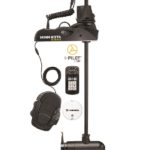Cruising in your favorite waters is an enjoyable and fun experience in summer. Contrary to the general misconception, your ideal fun fishing expedition doesn’t only depend on your trolling motor’s horsepower, but you have to take the shaft length into account and adjust it accordingly.
The shaft length plays a pivotal role in every fisherman’s boat. Getting it wrong can affect your catch’s quantity. In this post, you will get an in-depth overview of how to measure trolling motor shaft.
Why Is It Important to Select the Right Shaft Length for Trolling Motors?
While setting up a trolling motor for your boat, you will have to figure out the right shaft length. It’s necessary because it guarantees that the shaft is long, keeping the propeller submerged 12” under the water line in different fishing conditions. Also, make sure that the propeller doesn’t come out of the water in the middle of normal operation.
Although shaft length is a critical aspect, make sure that it is not too long or it will make it hard for you to stow.
Steps to Measure Shaft Length
Adhere to the following steps to measure your motor’s shaft length.
- Place the trolling motor on the ground.
- Determine the motor shaft’s length.
- Use a tape measure and determine the motor shaft’s length by measuring from the base of the head down to the propeller housing in inches.
Steps to measure transom or bow height
Measuring the height of your boat from the water is equally if not more important than measuring your motor. When buying a new motor knowing your boat height can make the difference between getting the right motor or the headache of exchanging it.
- Check your boat’s transom or bow to determine the mounting location, then place a flat object, like a 12-inch plywood scrap, on that spot slightly hanging over the edge of the boat.
- Get a yardstick, or a plumb line, to measure on a vertical plane from the boat’s surface, the bottom of your flat object, to the water. In this way, you will have an approximate vertical measurement of the waterline. Always draw an imaginary vertical line then round up to the nearest inch.
- Utilize the tables below to get the shaft’s approximate length for your boat. For instance, if your water line is 16 inches for a bow mount motor you will want a 42-inch motor shaft or a transom mount motor you will want a 36-inch shaft.
Check out our article Is an electric trolling motor right for my boat?
Bow Mount Shaft Length
You have to be more careful regarding the correct shaft length selection when it comes to bow mount motors. This is because the bow moves more on the water than the transom. Bow-to-water distances may vary to a significant extent. Therefore, choosing the correct shaft length is crucial in this scenario. At first, measure the distance from the waterline to the bow’s horizontal mounting point. Next, extend this measurement by 20″. Usually, you will need a shaft length that is greater or equal to this sum. Additionally, keep the following factors in mind.
- For fishing in the rough motors, extend the recommended lengths by 5”. In this way, you can keep the propeller submerged.
- While steering a hand-controlled motor standing up, extend the transom length by 12”. It makes steering comfortable and easier.
Note: don’t forget if you are using a mounting bracket you will need to add the thickness of the bracket to your bow height measurement.
Bow Mount Shaft Length
For freshwater, your minimum required shaft length should be 20” from the bow to the water line.
For saltwater, your minimum required shaft length should be 25” from the bow to the water line.
Here are the recommended shaft lengths.
| Bow to Waterline | Recommended Shaft Length |
| 0” – 10” | 36” |
| 16” – 22” | 42” |
| 22” – 28” | 48” – 52” |
| 28” – 34” | 54” – 62” |
| 34” – 44” | 72” |
Transom Mount Shaft Length
Although shaft length is less important on transom mount motors, you still have to double-check.
| Transom to Waterline | Recommended Shaft Length |
| 0” – 10” | 30” |
| 10” – 16” | 36” |
| 16” – 20” | 42” |
| More than 22” | Discuss with the manufacturer |
Tips for Trolling Motor Shaft Length
It’s quite easy to measure the right shaft length for electric trolling motors. Adhere to the following tips for the best outcomes.
- You can get accurate readings in calm water, so measure your shaft length accordingly.
- Keep an eye on the additional weight directly over the bow. In lighter boats, you will notice that your bow dips more than expected.
- If possible, conduct measurement with a complete fuel tank and with all the relevant gear. This will help in identifying how much your bow rise will be affected. Your objective is measuring under “real world conditions.”
- Irrespective of your installation, you have to consider the weight of both the motor and batteries. For instance, two 12v batteries and a 24v motor weigh as much as an average human.
Rules to Remember
There are some rules that can also help you with the shaft length.
Submersion Rule
The top of the motor has to be submerged 12” or more under the water. It makes sure that you have enough power to inhibit noisy cavitation, preventing the fish from getting scared.
Go Long
If you can’t make up your mind between two lengths, choose the longer one. When you select a shaft that is too short there is nothing, you can do. But, in the case of a longer one, you have the flexibility to adjust its depth upward through the depth collar adjustment.
Engine Mount
There’s no need to worry about shaft length when it comes to the engine mount trolling motor. Therefore, you are only required to lower the shaft for bow and transom mount motors.
Measuring the Shaft Length of Your Current Motor
If you are looking to find out the current length of your shaft, it’s useful to learn the procedure of how to measure trolling motor shaft length. It’s measured from the motor head’s base to the propeller housing’s base. There are some exceptions due to the variations in manufacturing design by each brand.
Dealing with Minn Kota and MotorGuide Motors
If you have a Minn Kota motor, add 20”, while adding 16” for the MotorGuide. Rough waters are tricky to manage; it’s recommended to use a longer shaft, keeping the prop 6” below the water as the boat rolls and pitches.
Factors That Come into Play While Working with a Boat’s Trolling Motor Shaft Length
The following factors can be extremely useful for managing a trolling motor’s shaft length.
Water Conditions
Always pay heed to the water conditions. There will not be too many waves if you are fishing on lakes and rivers. Hence, it’s a good idea to have a shorter shaft length for these scenarios.
If you plan to go in a larger water body where you are expected to counter extreme and turbulent waves, it’s better to have a longer shaft length. In this way, you are guaranteed to have an entertaining and hassle-free fishing experience.
Clearance
Based on the structure and design of your boat, you may have enough room in front of the bow fencing, providing for the motor’s mounting.
In some boats, there’s not enough room between the fencing and the bow on the front edge. For such scenarios, you have to make certain modifications.
If you intend to get a new bow mount for your trolling motor, you should cut or reshape your boat bow’s front gate. Design adjustments don’t require a great deal of work – you can complete them within an hour. It’s recommended to choose an affordable way. If you want to save money while adjusting the front gate, place the trolling motor at the rear end.
Thrust
Thrust is used to measure the rating of a trolling motor. As a rule of thumb, note that a 75lb of thrust is almost equal to one horsepower or 764W of power.
A standard 12V motor that uses 60A consumes 720W. Thrust and voltage go hand in hand – the greater the thrust, the higher the voltage. Trolling motors come in 12V, 24V, and 36V versions. At max, thrust is around 55lb for 12V and 80lb for 24V.
Placement
The placement of your trolling motor plays a crucial role in the motor’s shaft length.
One of the most common methods is to place the motor on the bow. Other options include installing it at the rear end. Another feasible option is to place it on the central motor.
You must know that there’s no right or wrong placement option. But, you need to think about certain considerations. For instance, you need a longer shaft length for placing the motor on the bow. The reason is simple – the bow is higher in comparison to the boat.
Deciding Shaft Length for the Types Boats
- Boats that require short shafts include small sailboats, canoes, and zodiacs.
- Boats that require a long shaft include pontoon boats and Carolina Skiffs
- Boats that require an extra long shaft include boats with a high transom and barges that need a considerable amount of thrust.
Final Thoughts
Now that you know how to measure trolling motor shaft length, stick to the instructions mentioned above. This will ensure that you will have excellent results whenever you set out for an adventure on your boat.



